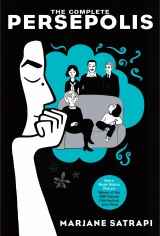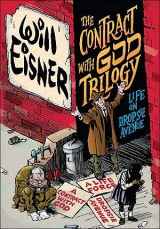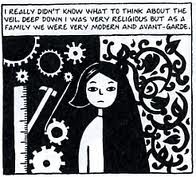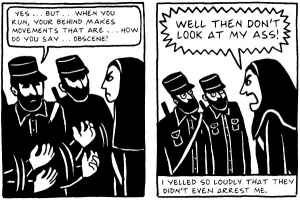How the Graphic Novel Has Made Its Way Into the Literary Canon
 I was first introduced to The Complete Persepolis by Marjane Satrapi in a literature class last fall. I ended up finishing it one sitting, unable to put it down. I was required to read it again in a different class the following semester which indicated to me that this graphic novel was very important.
I was first introduced to The Complete Persepolis by Marjane Satrapi in a literature class last fall. I ended up finishing it one sitting, unable to put it down. I was required to read it again in a different class the following semester which indicated to me that this graphic novel was very important.
It struck me that this graphic novel was not only quite popular (listed as #5 on Newsweek’s ten best fiction books of the decade) but also being taught alongside timeless classics such as Pride and Prejudice, Jane Eyre, and Wuthering Heights, prompting me to ask: why is this graphic novel so important? How is it that a graphic novel has made its way onto the syllabus of classes around the country and into my own literature classes, not once, but twice in one year? It seems that this is a question of the canon—can the literary canon grow to accept graphic novels?
The Western canon is essentially a body of literature (or music or art) that has proven to be highly influential on culture and society. This means that any book that has had a compelling influence on a significant number of people becomes a part of the canon. The canon can and should be expanded to include graphic novels, due to their growing popularity.
The graphic novel is a fairly new genre which began with cartoonist Will Eisner in 1978. His collection of stories about a poor, crowded Jewish neighborhood in the Bronx called The Contract with God, coined the term “graphic novel”. Since then, the graphic novel’s popularity has skyrocketed, especially among young adults. It is important to distinguish a graphic novel from a comic book—graphic novels are generally longer and tells a complete story, unlike comics which are issued in successive installments.
With the rise of graphic novels comes their inclusion into curriculum across the country, as instructors embrace their literary merits. Both teachers and professors are particularly drawn to this genre given its ability to engage the reader as a visual medium that combines text and art, adding to the variety and excitement that a graphic novel presents. Graphic novels can engage even the most reluctant readers, lending to its use in the classroom as a tool for literacy.
Persepolis isn’t the first graphic novel to be taught in the classroom; other graphic novels have made their way into the college syllabus and even high school curriculum, given their appeal to young adults. Popular titles with powerful storylines such as Maus and even Watchmen have also been taught. Maus was one of the pioneers of the genre; initially conceived in a three-page comic strip in 1972 and finally published in 1991.
even Watchmen have also been taught. Maus was one of the pioneers of the genre; initially conceived in a three-page comic strip in 1972 and finally published in 1991.
I believe Satrapi’s extraordinary story is made much more effective through the medium of a graphic novel. By doing so, Satrapi has lifted her message out of black-and-white words on a page and has illustrated it in front of the reader’s eyes. The graphic novel is universal and complex in a way that 18th century classics cannot be. By being able to breach the barrier between those who typically read lengthy novels and those who prefer visual representations, graphic novels provide a unifying medium for literary experiences. As a genre, the graphic novel engages a wide audience, is easily translated into many languages, and is appealing to the eye.
The storyline of Persepolis itself is fascinating—I couldn’t put it down my first time through. It’s an autobiographical novel about growing up in Iran during the Islamic revolution. This graphic novel is quite illuminating for someone unfamiliar with Iran and its people; it is an essential look at the life of a girl in Iran and her relationship with her very liberal parents and how she relates to her peers. In her dealings with others, even the law, Satrapi is bold and honest, which are admirable traits— I often found myself wondering how I would have reacted if I were in her shoes.
 Satrapi’s representation of herself in this novel has a universal appeal because she is unflinchingly honest and remains true to herself, despite the obstacles such blunt honesty creates. Satrapi does not necessarily prescribe to the tenants of Islam; rather, she thinks critically about her views and how she feels, preferring to think for herself. This stems from the way her parents chose to raise her, providing books and encouraging her to read them and form her own opinions. There are many mentions of communism and Karl Marx in this novel, referring to the books she has read and her radical, communist family members who rebel against the Islamic regime. Providing such a perspective of an Iranian family is very different, intense, and fascinating.
Satrapi’s representation of herself in this novel has a universal appeal because she is unflinchingly honest and remains true to herself, despite the obstacles such blunt honesty creates. Satrapi does not necessarily prescribe to the tenants of Islam; rather, she thinks critically about her views and how she feels, preferring to think for herself. This stems from the way her parents chose to raise her, providing books and encouraging her to read them and form her own opinions. There are many mentions of communism and Karl Marx in this novel, referring to the books she has read and her radical, communist family members who rebel against the Islamic regime. Providing such a perspective of an Iranian family is very different, intense, and fascinating.
The way in which Persepolis deals with difficult subject matter is another reason why this novel is so appealing, using humor at times despite the troubled period during which she grew up. This novel portrays a child and then a young adult frustrated with the limitations that life in Iran imposes on her. Satrapi’s reactions to certain things are indeed funny but also shed insight into Satrapi’s sense of entrapment and inability to fully be herself while in Iran.

Between dealing with controversial political issues, war, and a rather naïve but delightful protagonist who doesn’t know any better than to be true to herself at all costs, I believe this graphic novel has proved its literary merit, rightfully earning its place as one of the best works of fiction in this decade. In the ten years since it has been written, it has grown rapidly in popularity and is distributed around the world. Compared to classic literature, this graphic novel has done something entirely different—it has achieved international relevance rather quickly and, unlike the classics which are valuable but have a reputation for being stuffy, is immediately engaging and would appeal to almost anyone.Another unique aspect of Satrapi’s graphic novel is her use of interiority—a term that is often used in literary theory and refers to the way in which a work focuses on what the protagonist is thinking and how they feel. The concept of interiority became very important during the 18th century, which revolutionized literature and is a topic that scholars still write about and discuss. Satrapi utilizes interiority to help the reader become a part of her world; she makes the reader feel invested in Satrapi’s life, especially through her charming young character.
What do you think? Leave a comment.











Persepolis is very hyped but deservedly so. It’s Wonderfully personal, often in touching and tragic ways. A modern classic for sure.
Agreed! Very true. It definitely touched me.
Loved Persepolis and thanks to your article I now have to hunt down ‘The Contract With God’.
Great article. Graphic novels should definitely be read more widely, as they are such wonderful amalgamation of visual art and complex storytelling. You have inspired me to read “Persepolis”, as I have only seen the film adaptation. I loved “Maus” as soon as I started, and I could not put it down either. Also, need to read “Watchmen”, after seeing the film adaptation. Love the article.
I have yet to see the film adaption of Persepolis! I am looking forward to when I finally get the chance.
Graphic Novels are a seriously under-appreciated art form. They definitely deserve a place among the great works of literature. What do you think about electronic graphic novels?
I looked this up. Do you mean like graphic novels in a digital format on Kindle or iPad? I think this is an interesting concept. Especially because people tend to complain about reading text on digital devices but perhaps they would be the perfect medium for graphic novels and comics.
Agreed! I didn’t know Persepolis had started being taught, that’s great to hear. Like you I read it in once sitting, and it was my gateway drug into other graphic novels.
Exactly! Persepolis completely changed my perception of graphic novels.
I never really gave graphic novels a chance. Then I read “Maus.” As corny as it sounds, it honestly changed me. In terms of Holocaust stories, “Maus” connected with me more than “The Diary of Anne Frank” or “Night.” (Now I kind of feel unsettled because I essentially just ranked Holocaust stories…) Initially, I thought it was odd to have such a story told in graphic novel form, but any confusion or apprehension I had faded after the first couple pages. I don’t know if I really felt it because of the graphics considering I’m a more visual person, but I recommend “Maus” any chance I get.
I was discussing Maus with a professor a couple weeks ago as something that he had taught in the past. So far I have only looked it over but I intend to read it soon. I hear so many good things!
Great article! Two of my English Literature modules have set graphic novels as reading too! I definitely agree with you that the graphic novel form has a vast potential for portraying subjective thought and experience, especially due to its unique focus on the visual.
Yes, I definitely found it fascinating that graphic novels are making their way into literature classes! Like you said, it indicates that graphic novels have a lot of potential!
Great article! I just studied and wrote about Alison Bechdel’s Fun Home as part of my course where i too studied Persepolis and Maus. Admittedly i was not looking forward to the module, being a bit of a literature purist..! However, Fun Home turned out to be the most enjoyable and thought provoking text on the course. It was moving, relatable and intelligent and has since completely changed my perspective on the Graphic Novel! Being a student of Art History as well Fun Home proved to be an excellent text which bridged the gap between the two disciplines-highly recommended! I hope Graphic Narratives continue to find their way into the curriculam at all levels!
I will have to read Fun Home! I understand how you feel about being a literature purist, as my classics are very important to me. I did not have a problem reading Persepolis at first, I think I was mostly intrigued. Like you, Persepolis opened my eyes to how wonderful graphic novels can be.
Definitely! i really found, to my surprise, it opened up the idea of literature. The levels of interest and analysis inherent to Fun Home sort of blew my mind as i read on aha!
Well done, Sierra! I have never read a graphic novelnbut know I’ll start with this one, your article having convinced me it’s a worthwhile effort. Thanks for your informative and thoughtful presentation.
This was an interesting and enjoyable read. It’s great to see graphic novels being more widely viewed as a serious form literary form; comics are a popular field of study at my university, but they’re still often viewed as a geek culture indulgence by those outwith academia. I haven’t read Persepolis or Maus yet, having gotten into the genre through the likes of Sandman, V for Vendetta and Watchmen, but it’s definitely on my list. Thanks for posting!
Very good point! While doing some research for this article, I read articles that scholars wrote about Persepolis. I believe graphic novels are rapidly losing their perception as something that is “geek culture” and gaining literary merit.
I’m going to join the chorus and say what a great article this is. I haven’t read Persepolis (yet) but everything I’ve heard about it has been wonderful. Through my reading of various graphic novels, I’ve found that I really relate to your points on the unifying nature of the graphic novel and its ability to educate readers on different aspects of life that many may not be totally familiar with. The industry has attracted a high number of very talented writers who seem particularly interested in the creation of auto-biographies and works that act more as humorous visual journals of their lives. In the past, I’ve read a number of works that really expanded my understanding of cultures and social backgrounds that I otherwise may not have experienced had they been presented to me as a non-fiction novel or film. Perhaps moreso than other mediums, I think the graphic novel holds a lot of power in allowing greater numbers of people a voice and challenging the literary canon.
Love this. Completely agree, there are so many benefits in the graphic novel. I have only just started reading them last year and find them incredibly moving. I must keep an eye out for Watchmen, it seems intriguing. Your points are articulate and persuading and I do feel the Western Canon would benefit more from including graphic novels – they are incredible and offer so much to the reader.
Thanks for this article. I’ve read the first part of Persepolis, but not the complete series, but it was quite wonderful.
I would have to argue that while some classics may be seen as stuffy, but it’s only because literary canon has been limited to just novels. Do you think that if comic strips or comic books had been considered for literary canon that they’d be included in literary canon today?
Graphic novels are far richer than one might expect, and seriously underestimated. Persepolis is eye-opening and traces Iran’s history in a detailed yet simple way. The readers identify to the story. Even though it is set in a precise socio-political context that is very distant from Western society, anyone can recognize himself/herself in the protagonist, in her personal struggles over depression, in her convictions to live her life the way she wants, and in the way she is constantly brought down and restrained by some kind of authority. Great article!
I would have to say Watchmen has played the most instrumental role in elevating the graphic novel to a more widely respected artistic medium.
This is fanatastic. I like this article. I almost would love to see a follow up which delves further into Persepolis, or expands on how Graphic Novels can be used in Classrooms today.